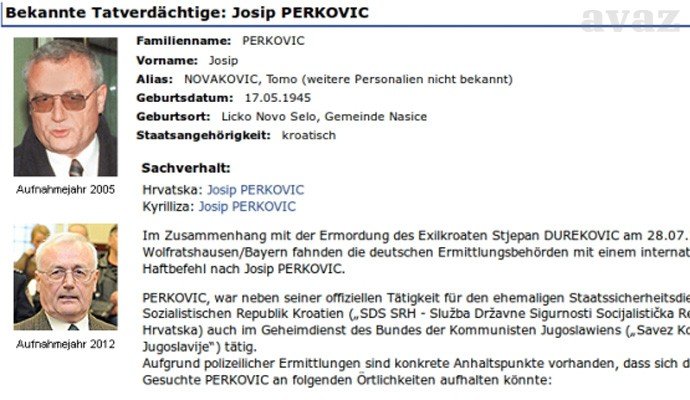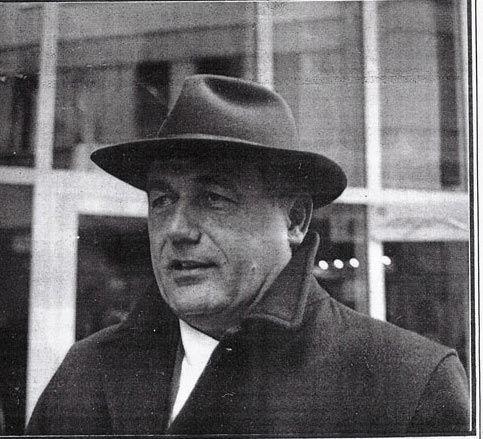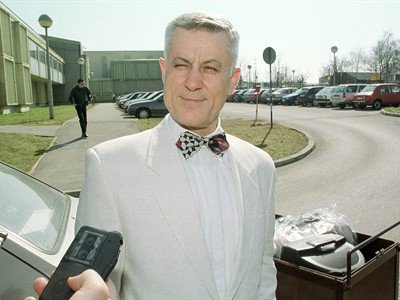Croatia and the Malodorous UDBA Ghosts
The following is an English translation of an article that was first published in French on the influential Polemia.com site.
 The German BKA arrest warrant for Josip Perkovic (former head of the Communist Secret Police in ex-Yugoslavia)
The German BKA arrest warrant for Josip Perkovic (former head of the Communist Secret Police in ex-Yugoslavia)
The recent diplomatic dispute between Berlin and Zagreb, as well as the conspicuous absence of German Chancellor Angela Merkel during the festivities on July 1, 2013, which marked Croatia’s entry into the European Union, brought into the limelight the unresolved question of crimes committed by the UDBA (1), the former Yugoslav communist secret police. The dispute between the two capitals about the extradition of Josip Perkovic — which official Croatia is strongly opposed to – even resulted in the adoption of special law on his behalf. This individual, who still savours his retirement days in Croatia, had very likely masterminded, sponsored and planned (among other crimes) the murder of Stjepan Durekovic, a political émigré who had savagely been killed by a bunch of Yugoslavian henchmen on July 28th, 1983 in the suburbs of Munich.

Josip Perkovic
Seen as an absolute nightmare for 45 years by Croatian émigrés and nationalists, the baleful UDBA managed to sneak through the recent war of Croatia’s secession (1991 – 1995) and survived the regime change. It rallied behind the first president of Croatia Franjo Tudjman, in order to avoid “lustration” (purges), with most of its senior executives now becoming cogs in the new machinery of the new Croatian state. Ministries, the Parliament, media, big business, administrations, diplomacy — rare are public fields where these former “suradnici” (aka “snitches”) don’t hold major positions. For example, in a recent article (June 10th, 2013), the Daily Mail writes about the surprising appointment of Croatian politician Neven Mimica, as a European Commissioner. Mimica is described as a former member of the Yugoslavian secret police. With a monthly salary of 20.000 Euros, Mr. Mimica is the best paid civil servant in Croatian history. This explains why the present government (run by non-repentant old communists and their younger “liberal” offspring), is reticent to hand over their old buddy to the German authorities.
Rusticity and Efficiency
Born in 1946 as part of the Ministry of Home Affairs, the Yugoslav communist secret service, the UDBA, was conceived as a counter-intelligence agency and a political police, the latter being by far its most important task (2). The UDBA consisted of four major sectors (“internal enemy,” “hostile emigration,” “foreign espionage,” “high tech espionage”). It employed hundreds of agents, analysts, and agents (“suradnici”), as well as thousands of snitches, i.e. informants (“informatori”). Founded as a dense conspiratorial network, it operated in various regional centers in ex- Yugoslavia, being active in all towns and villages in each constituent ex-Yugoslav republic. The whole spying apparatus was monitored by the national UDBA Directorate (i.e., in Zagreb, the capital of the ex-Socialist Republic of Croatia), with its federal headquarters located in Belgrade, the capital of ex-Yugoslavia. Unlike the traditional modus operandi of many other communist countries, local UDBA centers in ex-Yugoslavia enjoyed a large degree of autonomy with each local center supervising the agents in its respective area. However, the 2nd Section was also in charge of hiring its own quota of undercover agents abroad.
The operatives of the 2nd Section were generally groomed for their prime targets: infiltration of Yugoslav and especially Croat émigrés abroad. Generally, and except for some isolated cases (3), the educational level of these agents was relatively low(4), which doesn’t mean that in practice they were not devious and malevolent enough, as was shown by their bloody track record. As regards the Croatian emigration, the UDBA carried out at least 68 to 69 homicides, 5 abductions whose victims were later executed, 23 attempted murders (with several cases of severely injured victims), 4 abductions whose victims survived and 2 attempted kidnappings.
The branch which was in charge of the “internal” enemy had a more educated staff as the Yugoslav government’s paranoia was so large as to make it tap into the pool of possible agents and informants in various ministries and even the clergy, but also recruiting members from the Communist League, the press, radio and TV journalists, judges, attorneys, teachers and commercial managers. Overall, and given the extent of its large network, the UDBA had become the main pillar of the Yugoslav Federation and its communist regime. Feared for its pervasiveness and its omnipresence, the UDBA was also dreaded for its extremely savage proceedings.
“Gangsta” Methods
If one can admit that collecting political, military or economic data is needed in an effort to protect a country and thus bring some advantage to the security of its citizenry (5), then the UDBA work, which consisted in spying on one’s compatriots (6), brutalizing, and terrorizing and murdering them, should be qualified as pure savagery. For almost fifty years (from 1946 to 1990), this was precisely the job of the Yugoslav UDBA.
Arbitrary detentions, beatings and miscellaneous abuses (7) were typical of the UDBA’s daily menu. For example, Ivan Gabelica (a law student and later attorney) was arrested in 1965. He was kept for 45 days with his hands handcuffed behind his back which seriously injured his hands and caused him a permanent handicap. In 1980, a young student Ernst Brajder died under “mysterious circumstances” while in the custody of the UDBA headquarters in Zagreb. This occurred with the tacit agreement of Yugoslav prosecutors and judges who turned a blind eye on illegal phone tappings and systematic breaches of the privacy of private mail. On the other hand and, and despite all of its all efforts, the UDBA could not be present everywhere and all times. Hence, the UDBA was obliged to use the services of ordinary people and it even provided a toll-free number for “rat out” calls.
The 2nd Section in charge of countering the actions of “hostile emigrants” was even more violent as it didn’t hesitate to resort to “offensive” or “special” operations, i.e., assassinations. By bribing and manipulating common criminals (threatening them, or promising them impunity), by fabricating false documents (8) and exerting the most infamous blackmails, it induced naive citizens in ex-Yugoslavia into suicidal plots, or framed them with offences they had never committed (false flag operations). In short, the 2nd Section run by Josip Perkovic – was quite simply an organized crime agency.
Formidably efficient, the UDBA did succeed to arouse in the Croatian diaspora an acute persecution paranoia, a real psychosis which spoiled community relations and prevented émigré Croats from launching any large-scale action. It also succeeded in undermining the emigrants’ reputation by defaming them as “terrorists” in their host countries. For example, a famous case took place in Australia where, as a result of UDBA media manipulation, six young Croats (the “Croatian Six”) landed behind the bars for 15 years (see Hamish McDonald, “Framed: the untold story about the Croatian Six”, The Sydney Morning Herald of February 11th, 2012).
Incidentally, and in addition to this scary picture of the UDBA, it is worth mentioning that the Yugoslav regime had issued some rules (9) for the security services. Article XVI of these rules mandates that its agents “respect the free will, humanism, freedom and rights of the citizens.” The cynicism and hypocrisy are breathtaking.
An Unusual Cruelty
Skimming through the large list of UDBA’s crimes and notably the murders that were committed abroad by the 2nd Section, one cannot but notice the viciousness which characterized the killers (10). Often enough Croatian victims were betrayed by pseudo friends and they were either shot or pulverized by a bomb, or had their throats cut, or their head smashed with an axe. (This is the terrible way Jozo Orec, a Croatian emigrant, was killed in Johannesburg (South Africa) in December 1977.) On several occasions, relatives and even children of the targets were hacked to pieces. In August 1972 when (Steve) Stipe Sevo was shot (in the back of course) by his “friend” Vinko Sindicic, the killer Sindicic also murdered Sevo’s wife and his little daughter, Rosemarie, aged 9. Although he is suspected of having killed a dozen emigrants, Sindicic is currently free of any charge and swaggering around in Croatia, with a decent pension plan.

Vinko Sindicic
In Chicago the story was similar: in June 1977, an UDBA man killed Dragisa Kasikovic, a Serbian émigré by stabbing him 64 times, and then assassinated the man’s young stepdaughter (aged 9), who was stabbed 58 times with a knife.
This cruelty was probably due to the fact that in order to carry out “offensive operations,” the UDBA often enlisted criminals and psychopaths. Such tactics had a dual benefit: first, the executioner was completely unscrupulous and in case he got caught, it was impossible to prove that he had any links to the Yugoslav security service (11). Once their crime was perpetrated most murderers went back to Yugoslavia where they were granted amnesty, received money, or became owners of night clubs or restaurants on the Adriatic coast. Some of these killers are possibly still there…
It is neither wishful thinking nor schmaltz to claim that such deeds are not congruent with the intelligence service of a civilized country and that they dishonour forever the “officers” who ordered or allowed these crimes to happen.
Big-Time Tales
Concerned about blotting out its traces after the murder happened, the UDBA always took care to set up beforehand an appropriate environment that would later substantiate its thesis of an “internal settling of scores among émigrés.” Well informed by its stooges and agents about lesser incidents and quarrels which might have happened among its émigré enemies, the UDBA, if needed, was capable of instigating them itself (12). It took advantage of the mutual distrust among émigrés in order to strike. After “the kill was made,” the local police investigation quickly made it look as if there had been problems among émigrés themselves, thereby lending credence to the assumption of an “internal settling of scores.” It is obvious that such a ploy, by the very fact of its mimicry, could not deceive true specialists for long, and that a great deal of deliberate naiveté among host countries was indeed required in order to be fooled. Unfortunately, most Western countries had ample reason for their unwillingness to investigate Yugoslav Communist UDBA crimes because for geopolitical reasons “the non-aligned” Yugoslavia benefited from an enormous indulgence … and sympathy (13).
Sometimes this will to “ignorance” went so far as to create collusion; the security services of the emigrants’ host countries showed a strange short-sightedness vis-à-vis the UDBA scheming, or demonstrated unusual clumsiness when they pretended to bring to justice an UDBA killer. In the Durekovic case, it is really odd that it took no less than thirty years for the German Federal police, the BKA, to show any interest in apprehending Josip Perkovic. …
As far as France is concerned, it is strange that not a single UDBA murder or kidnapping of a Croatian émigré was ever solved during the Cold War. For example, on October 17th, 1978 Croatian journalist Bruno Busic was killed in Paris; the French police have never (officially) identified nor arrested the perpetrators of this crime. Later, it became known that the preparation for this operation had mobilized several agents and informants who had come to Paris along with several senior officers of the UDBA (at least three regional chiefs, a couple of national executives and one or two federal bosses). It seems unlikely that this unusual excitement and these comings and goings could escape the vigilance of the highly reputable French counter-espionage agency, the DST.
As an American intelligence expert put it recently: “Tito was an asset to the West so UDBA crimes were commonly ignored (…) During the Cold War, the UDBA assassinated more people in the West than the Soviet bloc countries did, but it has received very little attention in the Western media” (14).
An Unhealthy Impunity
Today, the malodorous UDBA ghosts and other Yugoslavian cloak and dagger circles are still haunting Croatia. Twenty years after its independence scores of former UDBA hit men of the former Yugoslav regime have not yet been held to account, nor have they ever atoned for their crimes. The brainiest ones have even retained important positions, or passed them on to their offspring. Most murderers today in Croatia benefit from a comfortable material situation; they are not bothered by the police and quietly enjoy their ill-gotten wealth.
Some of them have chosen to settle down in France where they spend happy days under the palm trees of the Riviera. Publicly accused (in Croatia) for having prepared or committed five or six murders of emigrants on behalf of the UDBA, the brothers J., aka “Simun” (or “Sime”) and “Djordje”, obtained French nationality; their case is subject to the statute of limitations dating from the end of criminal proceedings (10 years after a homicide was committed), assuring them of impunity. These two criminals have clearly nothing to feel sorry about.
Of course, national reconciliation is necessary, but it would be a gross mistake to believe that collective amnesia and impunity will do any good. Anglo-Saxons like to say that “crime doesn’t pay”. Well, with Perkovic, Sindicic and their communist ilk, Croatia is currently proving the contrary!
Christophe Dolbeau (see here and here) is a specialist on insurgency and espionage and author of many books dealing with communist crimes and the fate of East Europeans during the so-called Cold War. He is the author of Petit dictionnaire des résistances nationales à l’Est de l’Europe (1917–1989): Face au bolchevisme (Arctic, 2006). His latest one is La Guerre d’Espagne (Atelier Fol’fer, 2010).
________________________________________
Notes
(1) Uprava državne bezbednosti, i.e. Direction of State Security. From 1966 onwards, the service will be known as the SDB (Služba državne bezbednosti) and then SDS (Služba državne sigurnosti), i.e. Office of State Security.
(2) Yugoslavia had several other secret services: the Direction of Research and Documentation (Uprava za istraživanje i dokumentacije which became Sluzba za istrazivanje i dokumentacije – UID and then SID) which belonged to the Ministry of Foreign Affairs and cooperated with UDBA; the Military Intelligence Service (Vojnoobaveštajna Sluzba – VOS) and the Military Counter-Intelligence Service (Kontraobavestajna Sluzba – KOS). About the little known SID, see Berislav Jelinic, “In Addition to the KOS and UDBA, the SID also spied in Croatia”, Nacional, N° 538 (2006-03-06).
(3) Like Mitja Mersol, a Slovenian journalist, who infiltrated the BBC (See Jack Grimston, “Tito’s Spy Ring at heart of the BBC Unmasked”, Sunday Times, March 25th, 2012 – or the very noxious Miroslav Varos ( Seee Ivo Rojnica, “Zrtve udbine infiltracije”, Hrvatska Revija, N° 1 [157], March 1990, pp. 230-232.
(4) Here is a revealing incident: between 1969 and 1971, the UDBA was asked to provide a second liaison officer to the Australian secret service (ASIO), but in October 1972 ASIO was informed “that the Yugoslavs were unable to find a suitably qualified officer who spoke sufficient English..” The ASIO report is quoted and reproduced by Sasha Uzunov (see here.)
(5) Hence the famous aphorism of colonel Walter Nicolai and admiral Canaris : “Nachrichtendienst ist Herrendienst”…
(6) Dismissed in 1966, ex-Yugoslav Home Secretary Aleksandar Rankovic had 1,4 million Croat citizens in his police records.
(7) On several occasions UDBA wrote, printed and circulated fake issues of the Croatian émigré magazine Nova Hrvatska, published in London .
(8) “There grew a pervasive fear that among the ranks of the emigrants there may be an UDBA informant or agent” – T. Sunic, Titoism and Dissidence, Frankfurt, Peter Lang, 1995, p. 76.
(9) Pravila Sluzbe drzavne sigurnosti, as quoted by B. Vukusic in Tajni rat Udbe protiv hrvatskoga iseljenistva, Zagreb, Klub hrvatskih povratnika iseljenistva, 2002, pp. 112-131.
(10) “UDBA killings were often very brutal, more brutal than needed to kill” declares Dr John R. Schindler (see “Agents Provocateurs: Terrorism, Espionage and the Secret Struggle for Yugoslavia, 1945-1990”, in an interview published by Slobodna Bosna, February 4th, 2010 and reproduced in Studia Croatica, February 11th, 2010.
(11) “In most cases, the actual assassination was performed by an agent with mafia connections, not someone tied to the Yugoslav government”, John R. Schindler, op. cit.
(12) “Every assassination of a political emigrant was preceded by a “quarrel” with other emigrants instigated by the UDBA itself which had distributing leaflets stating that the “victim” himself was an agent of the UDBA “ ( Hans Peter Rullmann, Assassinations commissioned by Belgrade, Hamburg, Ost-Dienst, 1981, p. 13.)
(13) See T. Sunic and N. Stedul, “Marshal Tito’s Killing Fields”, in Pravda.ru.
(14) John R. Schindler, op. cit.





Comments are closed.